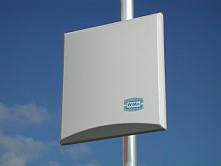One speaks of broadband technology, if information with a speed more largely a megabit per
second is to be transferred. In comparison the transmission rate of a ISDN line amounts 64
k-bit per second.
A high speed is needed to manage large data packets on the Internet to send or receive.
The broadband performance of a municipality may be done on cable as well as by radio.
The existing facility is the standard copper cable. This can transmit phone, television
and internet data. The transmission speed is in close range, i.e. up to 300 meters at 6
megabits per second. The problem lies in the high attenuation of the copper cable. In
rural areas, the speed in many cases, therefore, is less than 400 kilobits per second.
Who refers a television connection over "Cable Germany" or another offerer, also
can use the Internet services of these providers. The domestic installation must
eventually to be supplemented. Those usual speed is 6 megabit per second. There is also
higher transmissions to over 20 megabit per second possible.
The connection via fiber optic cable is the fastest and safest technology forward. Speeds
over 1000 megabits per second are possible. The fiber optic installation was previously
only in the cities accelerated. For the rural area are appropriate Provider concepts
necessary.
The German Federal Government promotes broadband via cable or radio total of 150
million euros. The information is available under
http://www.euinfo.de/download/?breitbandstrategie+buta+0209.pdf .
A healthy solution offers besides cable the Sky-DSL. Each user has to use an individually
satellite dish to access the Internet. Meanwhile, besides the download the upload is
possible at a speed of about 2 megabits per second. Providers are the German companies
Filiago and StarDSL.
Regarding health is
substantially more critical to see broadband supply by radio .
Various combinations are possible solutions:
The Urban supply is usually done with a Wi-Fi antenna as a distribution station at a
central location. The users require an own house antenna with directional radio character
for sending and receptions. The involvement of the distributor antenna in the place at the
distance network results either over directional radio or a cable connection of by German
Telekom.
In this solution, 20 to 40 participants must divide themselves the transmission capacity
in the place. In the ideal case, two to three Megabit per second are reached per user. In
the previously well known cases, the available transmission speed not contractually is
guaranteed of the supplier.
 |
The interior place supply
over WIMAX antennas is in some cities in the test phase. In this area romp about ca. 50
suppliers with partially unlicensed radio systems. The transmitting power can show a span
of 1 to 12 watt. Correspondingly differently the immissions fall out for the concerned
citizens. In a private apartment in
Spaichingen, Dr. Virnich was able to measure 274 Mikrowatt per square meter in the
distance of 125 meters. This corresponds the mobile phone load of GSM or UMTS in
comparable situations. Elsewhere was the immission with 1 to 2 Mikrowatt per square meter
comparatively low. |
The newest mobile phone generation is named
"Long Term Evolution" (LTE). Over the introduction period only can be speculated
first of all.
Community with a legally protected mobile phone location draft, such as the German city of
Lichtenfels (Bavaria), stand now before the task of expanding the location draft by new
radio solutions such as WIMAX and WLAN. Importantly is to declare radio technology for the
broadband transmission as „radio transmission“, because otherwise for the
location draft a legal gray zone emerges. Moreover is recommended urgently to enlighten
the population over the risks of the radio technology. Nevertheless is both WLAN and WIMAX
low-frequency pulsed. Otherwise the danger exists that clever providers could walk on to
ground owners and the location draft undermine.
Likewise, should be integrated the TETRA radio for police and other emergency services.
TETRA operates like GSM with low-frequency pulsed radio technology in the frequency range
of 400 megahertz. Similar radio networks can operate also tradesman on its company
premises. These designate itself as a DMR, digitally mobile radio.
That in 2010 blanketing used smart electricity meters of EON Bavaria are a large unknown
in the radio load. Currently there is a Pilot project in the municipality Bad Staffelstein
(Bavaria). If every household would transmit its Meter readings by GSM / GPRS modules
would be new transmitter locations possibly necessary.
Sources:
1) Presentation of Dr. Virnich in Lichtenfels on 2009-03-25
2) Own investigation
Photo source: www.wimo.com
|